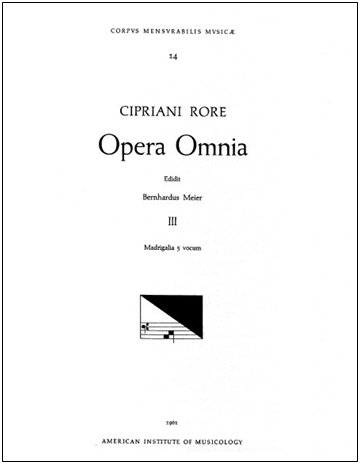| Version imprimante |
Bibliographie
Meier, Bernardus : Cipriani Rore Opera Omnia, Vol III : Madrigali 5 vocum
American Institute of Musicology (AIM), 1961

 Cette source est entièrement dédié à De Rore.
Cette source est entièrement dédié à De Rore.
 Il s'agit de l'édition nouvelle (XXème siècle) des partitions de De Rore: Ouvrir.
Il s'agit de l'édition nouvelle (XXème siècle) des partitions de De Rore: Ouvrir.
 Cite des sources des oeuvres de De Rore : -->
Cite des sources des oeuvres de De Rore : -->
 Cites des oeuvres de De Rore : -->
Cites des oeuvres de De Rore : -->
Cite les sources suivantes des oeuvres de De Rore
1 :
{Meier_III} - 1548_a : ''
-
p. 80
: Est mentionnée ici comme la source où on trouve le madrigal Ite rime dolenti
Naar top
1 : A che con nuovo laccio, 5vv (Madrigaal) - [0 2 : Domine Deus - Quis enim tibi - Tu ergo rerum, 5vv (Motet) - [1 3 : L'augel sacro di Giove (2p Ondi'il bel nome vostro), 5vv (Madrigaal) - [0 4 : O socii neque enim (2p Per varios casus), 5vv (Madrigaal) - [5 5 : Quando fra l'altre donne (2p Io benedico 'l loco), 5vv (Madrigaal) - [0 6 : Quando lieta sperai, 5vv (Madrigaal) - [Rore?, 5 Page (re)travaillée la dernière fois :
28/06/2022 12:08:52
Cite les oeuvres suivantes de De Rore
 , 4 Refs.,
, 4 Refs.,  , +T]
, +T]
-
p. III
: '. . . A che con nuovo laccio (sixth mode, transposed c'/c", a voci pari) , is distinguished both by the literary form of its text (that of the madrigal) as well as by the rare circumstance that it contains no word-painting, although words conducive thereto, such as "desio", "pietade" and "tante pene" are present. The "barbarism" which appears in all parts at the words "d'ardenté desio" (mm. 9-13) is a typical in a work by Rore, as is also the beginning motive itself, which, with its repeated tones, is more characteristic of the musical language of Arcadelt or Verdelot than of Rore. Nevertheless, despite such uncharacteristic stylistic features, there is as yet no sufficient bibliographic reason for questioning the authenticity of the composition.'
 , 2 Refs.,
, 2 Refs.,  , +Tne]
, +Tne]
-
p. VIII
 , 7 Refs.,
, 7 Refs.,  , +Te]
, +Te]
-
p. III
 , 5 Refs.,
, 5 Refs.,  , +Tnfe]
, +Tnfe]
-
p. III
 , 3 Refs.,
, 3 Refs.,  , +Tne]
, +Tne]
-
p. II
 , 6 Refs.,
, 6 Refs.,  , +T]
, +T]
-
p. II-III
: '. . . the sonnet setting Quando lieta sperai, based on a slight modification of the poem by Emilia Anguisciola , apparently enjoyed considerable popularity, since it is parodied in masses by Andrea Gabrieli and Philippe de Monte and also in a Magnificat by Orlando di Lasso. It also appears in lute tablature in the second edition of Vincenzo Galilei's Fronimo, whereby, however, it is attributed, not to Rore but to Morales. The attribution of Quando lieta sperai, found in this source, probably accounts for its inclusion in the Nuova Spoglia amorosa (RISM15935), with the inscription "di Morales secondo alcuni"; however, both the late date of these sources and the absence of similar ascriptions would argue against attributing the work to Morales, even as an "opus dubium". It must therefore be regarded as the work of Rore. With regard to modality, this is one of those numerous works which, with a finalis of a, are nevertheless designated as "quarti toni", even after the appearance of the Dodekachordon, according to which they would be classified as Hypoaeolian'
Mon code :
#Ref_6228